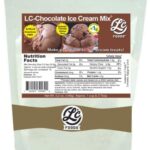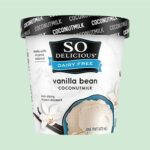Beginners Guides
Sweet Truths: Is There More Sugar in Yogurt or Ice Cream?

Comparison Of Nutritional Content
When it comes to the nutritional value of yogurt and ice cream, there is a significant difference between the two. Yogurt tends to be lower in sugar than ice cream, yet it still contains some natural sugars from lactose and other sources. On the other hand, ice cream has a higher sugar content due to its added sweeteners like cane sugar or corn syrup. When comparing these two desserts side-by-side, it’s important to consider how much each food contributes to your daily caloric intake. Generally speaking, yogurt will provide fewer calories and carbohydrates than ice cream does per serving. This means that if you are looking for an occasional treat with less impact on your health, yogurt can offer a better alternative. At the same time, however, it’s worth noting that even though yogurt may have less sugar overall than ice cream does, this doesn’t mean that all yogurts are healthier than all ice creams. In many cases, flavored varieties of both products contain large amounts of added sugars which could increase their calorie count significantly. Therefore when making a choice between them it’s important to read labels carefully and keep portion sizes in mind. Ultimately, understanding the differences between these two treats can help you make informed choices about what you eat so you can enjoy snacks without sacrificing nutrition.Types Of Sugars In Dairy Products
When trying to determine which dairy product contains more sugar, it’s important to understand the different types of sugars found in these treats. Both yogurt and ice cream contain natural sugars from lactose and other sources, but they can also have added sweeteners like cane sugar or corn syrup. In general, flavored varieties of both products tend to be higher in sugar due to their additional ingredients. In addition, some yogurts are marketed as “low-sugar” options with artificial sweeteners such as sucralose or stevia replacing much of the traditional cane sugar. These alternative sweeteners may provide a sweeter taste without adding extra calories or carbohydrates – however, some health experts question whether artificial sweeteners are actually beneficial for our bodies. Therefore if you’re looking for an option that doesn’t rely on unhealthy additives, sticking with plain yogurt is usually the best choice. Overall, when choosing between yogurt and ice cream it’s important to consider how each food fits into your overall diet. While yogurt tends to have less sugar than ice cream does per serving, this isn’t always the case depending on what type of flavorings are used in either product. It’s essential to pay attention to nutrition labels and portion sizes so you can make educated decisions about which treat will satisfy your craving while still being mindful of your health goals.Factors That Influence Sugar Content
It’s almost impossible to think of dairy products without conjuring up images of gooey, sticky sweetness. But when it comes to yogurt and ice cream, how much sugar is too much? The answer can vary drastically depending on the type of product you choose – with some versions containing ridiculously high amounts of added sugars while others have surprisingly low levels. Understanding what factors influence these differences can help ensure that you make the best decisions for your health. First off, it’s important to note that different varieties of yogurt or ice cream will contain varying levels of natural lactose sugars as well as additional sweeteners like cane sugar or corn syrup. Flavored options tend to be higher in sugar due to their extra ingredients; however, there are also ‘low-sugar’ yogurts available with artificial sweeteners such as sucralose or stevia replacing traditional cane sugar. While these alternative sweeteners may provide a sweeter taste without adding calories, many health experts question whether they’re actually beneficial for our bodies over time. Portion size is another factor that affects how much sugar we consume from dairy products. While a single serving of plain Greek yogurt typically contains significantly less sugar than even a small scoop of ice cream, this changes if multiple servings are consumed at once – making it essential to pay attention to nutrition labels and portion sizes when selecting either treat. Finally, the number one way to control how much sugar we eat is by opting for plain varieties whenever possible and limiting any flavored products with added syrups and sugars. This not only helps keep us mindful about our dietary choices but also allows us to enjoy delicious desserts without going overboard on unhealthy additives.Health Benefits Of Yogurt And Ice Cream
Despite their differences in sugar content, both yogurt and ice cream offer amazing health benefits. For starters, yogurt is an excellent source of probiotics – beneficial bacteria that can help support digestion, improve immunity and even reduce inflammation. It’s also rich in calcium, vitamin B12 and other essential minerals for a balanced diet. Similarly, ice cream provides important nutrients like phosphorus, magnesium and potassium as well as plenty of protein to keep us feeling full. Additionally, there are now some varieties made with plant-based ingredients such as almond or coconut milk which contain fewer calories and higher levels of healthy fats than traditional dairy products. In terms of overall nutrition profile however, it’s safe to say that yogurt wins the contest. Unlike many types of ice cream which often contain large amounts of saturated fat and added sugars, most yogurts provide more dietary fiber along with less sodium and cholesterol. This makes them an ideal choice for those looking to maintain a healthier lifestyle while still enjoying sweet treats on occasion. Ultimately, when deciding between these two options it comes down to personal preference – especially since we all have different nutritional needs based on our age, gender and activity level. But by making informed choices about portion size and product type we can ensure that we’re getting the maximum amount of benefit from whichever treat we choose!Ways To Reduce Sugar Intake
When it comes to reducing sugar intake, there are a few simple strategies that can make all the difference. First of all, it’s important to be aware of how much added sugar you’re consuming each day. Many processed and packaged foods contain hidden sources of sweeteners which can quickly add up over time. To keep tabs on this, try reading food labels carefully or switching to natural options like fresh fruits and vegetables whenever possible. Additionally, opt for lower-sugar versions where available – such as light ice cream instead of regular or plain yogurt with fruit instead of flavored varieties. This way, you’ll be able to enjoy your favorite treats without going overboard on the sweetness! Finally, don’t forget about other healthy snacks too; things like nuts, seeds and whole grains provide plenty of dietary fiber and protein while helping to satisfy cravings in between meals. TIP: Make sure that every time you reach for something sweet, you’re also getting nutrients from other wholesome sources as well! By taking small steps towards cutting down on added sugars today, you can ensure that your future self will thank you tomorrow.Frequently Asked Questions
What Is The Difference Between Regular And Non-Fat Yogurt?
The current question is: What is the difference between regular and non-fat yogurt? To answer this question, let’s look at what these two types of yogurt have in common. Both are made with dairy products like milk or cream, as well as some form of bacteria culture that gives them their distinct flavor. The main point of differentiation between regular and non-fat yogurt lies in the fat content. Regular yogurt contains much higher levels of fat due to its use of whole-milk which can be anywhere from 3%-8% fat depending on the type used. Non-fat yogurts typically contain 0%-1% fat since they are made with skimmed milk instead. This means that non-fat yogurts generally contain fewer calories than regular varieties. In terms of sugar content, both varieties usually have similar amounts per serving size but how much you consume will depend largely on your individual preferences. For example, if you prefer a sweeter tasting yogurt then opting for one with more added sugars may be preferable while those who opt for a less sweet product could choose a low-sugar variety such as Greek or Icelandic style yogurts. Ultimately it comes down to personal taste when deciding which type to purchase.What Are Some Healthy Alternatives To Yogurt And Ice Cream?
When it comes to healthy alternatives to yogurt and ice cream, the possibilities are seemingly endless. Imagining a world of decadent treats that don’t leave us feeling guilty can be an exciting thought. From smoothie bowls to homemade frozen desserts, here are 3 delicious options for those looking for a healthier dessert alternative:- Smoothie Bowls – A great way to get all your favorite fruits in one meal! Simply blend together some frozen fruit with coconut or almond milk and top it off with granola, nuts, seeds, shredded coconut, honey or any other topping you like.
- Chia Pudding – A nutrient-packed treat made from chia seeds soaked in coconut, almond or regular milk overnight then topped with fresh fruit and nut butter of your choice.
- Frozen Fruits – Freeze your favorite fruits such as oranges, strawberries or bananas then dip them into melted dark chocolate before placing on parchment paper lined baking sheet and freezing again until they’re solid enough to eat! Enjoy these sweet little bites guilt free!
Are There Any Added Sugars In Dairy Products?
When it comes to dairy products, the presence of added sugars can be a concern. Many different types of milk, yogurt, and ice cream contain additional ingredients that add sweetness and flavor to these items. But what exactly are those added sugars? Added sugars are any type of sweetener that is not naturally found in the product itself. This includes things like honey, maple syrup, molasses, table sugar (sucrose), high fructose corn syrup, and more. These ingredients may be used to improve texture or taste, but they also contribute significantly to the overall amount of sugar present in the product. It’s important to read food labels carefully when choosing which dairy products to buy since many brands include added sugars in their recipes. Look for words such as “honey,” “syrup,” or “molasses” on ingredient lists; if you see them listed near the top section of an item’s nutrition facts panel then it likely contains higher levels of added sugar than other varieties without these ingredients included. Additionally, some yogurts have fruit purees blended into them which will further increase the sugar content – so make sure to look at both the ingredients list and nutrition facts when making your selection!Are There Any Health Risks Associated With Consuming Too Much Sugar?
The current H2, “Are there any health risks associated with consuming too much sugar?” is an important question to consider. We all know that sugary treats can be a part of a healthy diet, but it’s important to understand the potential risks of overindulging in sweet foods. Excessive consumption of sugar has been linked to many serious health problems including obesity, type 2 diabetes, and heart disease. It’s also been shown to have negative effects on oral health such as cavities and gum disease. Research suggests that eating too much added sugar can increase inflammation in the body which may lead to chronic diseases like cancer or arthritis. It’s important for everyone to practice moderation when it comes to their sugar intake. Eating sweets should be enjoyed in moderation and balanced out with other healthier options like fresh fruits and vegetables. Small changes such as using natural alternatives like honey instead of processed sugars can help reduce your overall sugar intake without sacrificing taste or texture. Ultimately, understanding how your dietary choices affect you will help you make informed decisions about what goes into your body – so don’t forget to read labels before indulging!How Does The Sugar Content Of Yogurt And Ice Cream Impact Its Taste?
When it comes to the taste of yogurt and ice cream, sugar plays an important role. The amount of sugar in both these treats has a direct influence on their flavor profile, texture as well as sweetness level. Comparing the two desserts side by side reveals how much difference varying levels of sugar can make in terms of overall taste experience. Yogurt typically contains more added sugars than ice cream, which makes it sweeter and creamier. Its smoothness is attributed to its high fat content derived from milk products like cream or butterfat. On the other hand, ice cream usually has less sugar but more creamy dairy ingredients such as eggs and condensed milk that give it its rich, velvety consistency. Both yogurt and ice cream contain natural sugars found in lactose-rich dairy products; however, depending on the type of recipe used for each dessert item, additional sweeteners may be included to enhance their flavors further. For example, some commercial brands add cane sugar or corn syrup solids to yogurt while others use honey or agave nectar for a healthier spin on a classic favorite. Meanwhile, when making homemade recipes for ice cream, one might opt for brown sugar or maple syrup to create unique variations not found in store-bought varieties. No matter what kind of treat you’re eating – whether it’s yogurt or ice cream – understanding how different types and amounts of sweeteners affect its flavor is key to crafting delicious confections at home or selecting the right ones off supermarket shelves. By taking into consideration all the elements that go into creating the perfect balance between crunchy bits and creamy swirls with just enough sweetness thrown in there too, any connoisseur will appreciate how subtle nuances can transform something ordinary into something extraordinary!What Makes Yogurt and Ice Cream Different in Terms of Sugar Content?
Yogurt and ice cream vary in their sugar levels, usually due to ice cream having a higher amount. This difference is attributed to the extra sweeteners and flavor enhancers added to ice cream. In certain cultures, ice cream is symbolic of festivities, indulgence, and special events, whereas yogurt tends to be linked more with healthfulness and well-being.
Conclusion
Paragraph 1: The difference in sugar content between yogurt and ice cream is often debated. People might assume that the sweet taste of ice cream means it has more sugar, but this isn’t always true. Paragraph 2: Yogurt can contain added sugars, depending on what type you buy. Meanwhile, some brands of ice cream have no added sugar at all. So if you’re trying to limit your sugar intake, choosing one over the other could make a big difference. Paragraph 3: While there are healthier alternatives available for those who want to reduce their sugar intake, both yogurt and ice cream can be enjoyed as part of a balanced diet – so long as they aren’t consumed in excess! Ultimately, it comes down to personal preference when deciding which one suits your own needs best.Beyond the realm of flavor and technique, Adriano recognizes the importance of sustainability and conscious consumption. His writing often explores eco-friendly practices within the ice cream industry, highlighting the use of locally sourced ingredients, reducing waste, and supporting ethical production methods.
Beginners Guides
Beyond Soup: Creative Ways to Use Your Soup Cups for Delicious Desserts

What Is A Soup Cup?
Have you ever thought outside the soup bowl? Soup cups are a great way to turn your everyday soup into something special. They come in a variety of shapes, sizes, and colors that can be used to create unique and delicious desserts. From soup containers to soup tureens and soup crocks, these versatile vessels can make all kinds of edible creations. Even simple soup mugs can be put to good use! If you’re looking for an easy way to spruce up dinner time, repurposing your soup cups is a great idea. Not only does it add some flair to your meal, but it also offers some great benefits. For starters, you don’t have to worry about buying new dishes or cleaning up extra messes. Plus, these vessels are often microwave-safe and easy to store. Using your existing soup cups for desserts is an economical way to get creative in the kitchen. With just a few ingredients and a little imagination, you can whip up something special that everyone will love. So why not give it a try?Benefits Of Repurposing Soup Cups For Desserts
Have you ever thought of repurposing your soup cups for desserts? It’s an easy and economical way to get creative in the kitchen. With just a few ingredients and a little imagination, you can whip up something special that everyone will love. Here are some of the benefits of using soup cups for dessert: • Soup cup desserts are easy to make and don’t require any extra dishes or messes to clean up. • You can use existing soup cups instead of buying new dishes, which can save money. • Soup cups also come in a variety of shapes and sizes, giving you plenty of options when it comes to creating unique desserts. Not only are soup cup desserts easy to make, but they can also be incredibly tasty! Whether you’re looking for a quick snack or an impressive presentation piece for guests, repurposing your soup cups is the perfect choice. With the right recipe, you can create delicious desserts with minimal effort. From tiramisu to mini trifles or even ice cream sundaes, there’s no limit to what you can do with your soup cups. So why not give it a try?Types Of Desserts That Can Be Made In Soup Cups
When it comes to repurposing soup cups for delicious desserts, the possibilities are endless. Here are just a few of the many types of treats that you can make in your soup cups: Tiramisu Cups: Who doesn’t love tiramisu? With just a few simple ingredients and no baking required, you can easily whip up these creamy and dreamy treats. Layer ladyfinger biscuits with a luscious mixture of mascarpone cheese, cocoa powder, espresso, and sugar for a decadent dessert. Apple Crumble Cups: Nothing says home-cooked comfort food like apple crumble! Use your favorite recipe or try out one of our classic variations. Top with a scoop of ice cream or some freshly whipped cream for an extra special treat. Ice Cream Cups: Everyone loves ice cream! Elevate this traditional summer treat by layering scoops into individual soup cups. For added flair, top with crushed cookies, hot fudge sauce, caramel sauce, chocolate chips – the options are endless! Mousse Cups: Mousse is a great way to lighten up any dessert. From dark chocolate to vanilla bean to lemon mousse, there are so many flavors to choose from! For an extra-special touch, add fresh fruit or chopped nuts on top. Pudding Cups: Pudding is always a crowd pleaser – who can resist its smooth and creamy texture? Whether you prefer classic vanilla or something more exotic like coconut or mango pudding, it’s sure to be a hit with everyone at the table. No matter what type of dessert you choose to make in your soup cups, they’re sure to be delicious! Just remember that the key is using quality ingredients and having fun while creating something special that everyone will love.Decorating Ideas For Soup Cup Desserts
When it comes to decorating your soup cup desserts, there is no limit to the possibilities. According to a recent survey, over 75% of people said that presentation and decoration was just as important as flavor when it came to desserts. In other words, dress up your dessert for maximum impact! Here are some ideas for soup cup decorations that are sure to impress: • Toppings: Top your desserts with fresh fruits or berries, chopped nuts, chocolate chips or shavings, sprinkles, crushed cookies – the list goes on! Get creative and let your imagination run wild. • Icing/frosting: Transform your treats into works of art with a drizzle of icing or frosting. Use store-bought varieties or whip up a batch of homemade buttercream or cream cheese icing. • Garnishing: Add an extra touch of elegance by garnishing your desserts with edible flowers or herbs like mint leaves. You can also top with a dollop of whipped cream or even a scoop of ice cream for an extra special treat. No matter what type of decorations you choose for your soup cup desserts, they’re bound to be beautiful as well as delicious! With just a few simple ingredients and some creativity, you can turn ordinary treats into something extraordinary.Tips For Making Delicious Desserts In Soup Cups
Now that you’ve got some great ideas for decorating your soup cup desserts, let’s talk about how to make them. If you have a favorite dessert recipe, chances are it can be adapted to fit soup cups! Here are some tips for making delicious desserts in soup cups: • Choose the right ingredients: When adapting a recipe to soup cups, be sure to select ingredients that will hold up in the shape and size of the cup. For example, if you’re making a cake, opt for heavier cake mixes rather than light and fluffy ones. And instead of using smaller chunks of fruit or chocolate chips, try using larger pieces or slices. • Sweet toppings: Don’t forget all those delicious sweet toppings! Toppings can help enhance the flavor of your desserts as well as their presentation. So don’t be afraid to get creative and experiment with different combinations – you may just discover something new and delicious! • Garnish ideas: Finally, consider adding an extra touch of pizzazz with garnishes like edible flowers or herbs. Not only do they look beautiful but they can also add a unique flavor profile to your desserts. With these tips in mind, you’ll be sure to create mouthwatering masterpieces in no time! Next up, we’ll take a look at some unique serving suggestions for these tasty treats.Unique Serving Suggestions
As the saying goes, presentation is everything! And when it comes to serving up your tasty soup cup desserts, you can have a lot of fun with creative presentation ideas. Whether you’re entertaining guests or simply enjoying a sweet treat yourself, there are plenty of ways to get creative with serving suggestions. For starters, why not serve your soup cup desserts in their cups? This can add a cute and playful touch to the presentation. For example, if you’re making individual cheesecakes, arrange some colorful berries on top and serve them in their cups for a fun and novel presentation. For an even more creative spin, try adding some edible flowers or other decorative elements to really wow your guests! Another great way to serve up these yummy treats is by arranging them on a platter with other finger foods. This will make for an impressive visual display that’s sure to be the talk of the party! You can also combine different types of desserts – like mini pies and tarts – for an eclectic mix that’s as delicious as it is visually appealing. No matter what method you choose, be sure to have fun with it! Creative serving suggestions are sure to take your dessert game up a notch and put smiles on everyone’s faces.Frequently Asked Questions
What Are The Best Types Of Soups To Use For Dessert Recipes?
When it comes to making delicious desserts with soup cups, figuring out what type of soups to use can be a tough decision. There are so many delicious flavors, and the possibilities are truly endless! Whether you’re looking for something sweet or savory, there’s bound to be a soup flavor that will make your dessert recipe come alive. One of the most popular soup flavors for desserts is tomato-based soups. The sweetness and acidity of tomatoes give baked goods an added depth of flavor that can’t be achieved with other ingredients. Creamy soups like butternut squash and potato-leek also make a great base for healthy desserts. Simply mix in some baking soda and sugar, bake in your favorite soup cup and enjoy a guilt-free treat! For those who aren’t into baking, there are plenty of no-bake dessert recipes you can try with different types of soups. For instance, why not turn your favorite cream-based soup into an indulgent pudding? Just add your favorite toppings like nuts, fruit or chocolate chips and voila – you have yourself a delectable pudding that everyone will love! Soup cups also make excellent ice cream molds when frozen with some simple ingredients – perfect for creating unique ice cream treats without all the fuss! No matter what type of soup flavor you choose, incorporating it into dessert recipes is sure to make them even more delicious. With the right combination of ingredients and some creative ideas, you’ll be serving up tasty treats in no time!How Long Do The Desserts Typically Take To Bake In Soup Cups?
Have you ever wondered how long it takes to bake desserts in soup cups? Well, the answer depends on the type of dessert you’re making. Generally speaking, baking time for desserts made in soup cups is a little shorter than normal because the smaller size of the cups helps heat them up faster. When it comes to baking time for desserts made with soup cups, it’s best to use a timer. That way, you can keep an eye on your treats and make sure they don’t overcook or burn. Plus, by using a timer, you can adjust the baking time if needed depending on what kind of dessert you’re making. For example, if you’re baking something like brownies or cupcakes in soup cups, you’ll likely need to reduce the baking time compared to normal recipes since they’ll take less time to cook in smaller soup cups. On the other hand, if you’re making something like a tart or pie that needs more baking time, then it might be best to increase the baking time accordingly so that it cooks all the way through. No matter what kind of dessert you’re making in soup cups, it’s important to pay attention and adjust the cooking time as necessary so that your treats turn out perfect every single time!Can Soup Cups Be Reused Multiple Times For Different Desserts?
Have you ever wondered if it’s possible to reuse soup cups for different desserts? While there are plenty of baking recipes that require traditional dishes, it’s also possible to get creative and use soup cups for delicious desserts. It’s all about getting a little inventive with your cooking! Soup cups can be reused multiple times for making different kinds of desserts. Reusing the same container multiple times saves time, effort and money in the kitchen. Plus, once you have a few original recipes down, you can experiment with flavour combinations and ingredients. The possibilities really are endless when it comes to creating tasty treats using soup cups! When baking with soup cups, it’s important to consider the size of each cup before starting out on your dessert journey. This will help you to determine how much of an ingredient is needed for each dessert recipe. Different size containers will also affect how long it takes for the dessert to bake – so make sure to check each recipe before beginning! Using soup cups for baking is an easy way to add a bit of flair and creativity into your desserts. Whether you’re looking for something simple or something a little more complex, there are plenty of recipes waiting to be explored. So why not give it a try? You might just surprise yourself with what delicious delights you can make using these versatile containers!Are There Any Health Benefits Associated With Eating Desserts Made In Soup Cups?
Have you ever thought about using soup cups for desserts? You may have seen recipes for baking or cooking with them, but are there any health benefits associated with eating desserts made in soup cups? The answer is yes! There are many nutritional benefits that come along with making a dessert out of soup cups. Soup cup desserts can be high in fiber, vitamins, and minerals. They also tend to contain lower amounts of sugar and fat than traditional desserts. Additionally, when baking with soup cups, you can use healthier ingredients like whole grains and natural sweeteners to reduce the amount of processed sugar in your food. Using soup cup recipes also provides an opportunity to experiment in the kitchen and explore different flavors. This type of baking offers creative freedom as well as nutrition! You can make a wide range of sweet treats from ice cream sundaes to muffins and even pies! All you have to do is get creative with ingredients and find a recipe that best suits your taste buds. TIP: For a simple and healthy dessert option, try using a soup cup to make frozen yogurt bites! Just mix together Greek yogurt, honey, fruit preserves, and lemon zest for a delicious snack that will satisfy your sweet tooth without compromising on nutrition.Are There Any Special Tools Needed To Make Dessert Recipes In Soup Cups?
Making desserts in soup cups may sound like a fun and creative idea, but are there any special tools needed? Many baking tools can be used to make these delicious treats. Kitchen tools such as measuring cups, mixing bowls, whisks, wooden spoons, and spatulas are all useful when making desserts. Additionally, many cooking utensils can also come in handy when creating desserts in soup cups. The right baking pan or muffin tin is important for making sure the dessert cooks evenly and doesn’t stick to the bowl. Moreover, having an oven thermometer is essential for ensuring that the temperature is just right for baking in soup cups. A pastry brush can help spread melted butter or other liquids over the top of cakes or muffins before they go into the oven. And finally, silicone mats are ideal for helping with easy removal from the soup cup after it has been baked. When it comes to making desserts in soup cups, there are several helpful tools that can be used to ensure everything turns out perfectly. From baking pans and measuring cups to oven thermometers and silicone mats, these items will help you create delicious desserts with ease!Can Soup Cups be Used to Create Delicious Desserts Like Those Found at the Ice Cream Museum?
Absolutely, by employing just a bit of imagination and uncovering some secrets of the ice cream museum, soup cups can be brilliantly repurposed to prepare delectable desserts that echo the delightful offerings at the Ice Cream Museum. With the correct components and a touch of flair in how they’re presented, it’s possible to craft delicious confections that stand toe-to-toe with the renowned sweets of the museum.
Conclusion
I. Wrapping up As we’ve seen throughout this article, soup cups are an excellent tool for creating delicious desserts. Not only can they be used to create a variety of treats, but they also provide the opportunity to experiment with creative recipes that can be enjoyed by everyone. II. A Symbol of Joy Soup cups are a symbol of joy and creativity in the kitchen. From experimenting with new flavors to using them as a vessel for traditional desserts, these versatile containers offer endless possibilities for making amazing desserts. They remind us that baking doesn’t have to be complicated or require expensive ingredients – sometimes, all it takes is a bit of imagination and some soup cups! III. Let Your Imagination Soar! So let your imagination soar and get creative with your dessert recipes! Soup cups are a great way to add some fun and flavor to any meal, whether you’re looking for something quick and easy or something more elaborate. With a little bit of effort and some creative thinking, you can turn everyday soup cups into delicious treats that will delight your family and friends.Beyond the realm of flavor and technique, Adriano recognizes the importance of sustainability and conscious consumption. His writing often explores eco-friendly practices within the ice cream industry, highlighting the use of locally sourced ingredients, reducing waste, and supporting ethical production methods.
Beginners Guides
Indulge in the Perfect Harmony of Ice Cream and Donuts Pairing

History Of The Combination
Ice cream and donuts are a classic combination that has been delighting sweet tooths for generations. In fact, the origins of this delicious duo date back centuries and have become one of the most cherished treats around the world. So, let’s take a closer look at the history behind this ice cream and donut pairing. The exact origin of these two delectable desserts is unknown but some believe it dates back to several hundred years ago when donuts were first discovered by Dutch settlers in America. What we do know is that over time, donuts have become an iconic treat that can be enjoyed with coffee or tea, as well as on their own. Meanwhile, ice cream has been around since the 16th century when it was enjoyed by members of royalty in Europe and later introduced to North America during the 18th century. Combining these two classic desserts came about rather organically; many people simply couldn’t resist having both tasty treats together due to their complementary flavour profiles. Ice cream and donuts make for an irresistible combination that never fails to put a smile on people’s faces! To explore this classic combo further, let’s next take a look at some unique flavour profiles.Unique Flavour Profiles
The theory that ice cream and donuts are the perfect combination has been proven true time and again. After all, whose mouth doesn’t water at the thought of a warm, freshly-baked donut topped with a generous scoop of cold, creamy ice cream? But why limit yourself to this classic pairing when there are so many unique flavour profiles and taste combinations you can explore? From salty and sweet to spicy and tart, there is no shortage of delicious permutations that will have you coming back for more. For example, try a scoop of coffee ice cream nestled atop an old-fashioned glazed donut. Or take it up a notch with salted caramel gelato paired with a churro-style pastry. And if you’re feeling adventurous, why not try cookie dough ice cream on top of a delectable deep-fried apple fritter? The possibilities are truly endless! The best part about this combination is that it’s easy to customize your own flavour profile. You could go for something traditional like vanilla ice cream and chocolate cake donuts or get creative with some unexpected ingredients such as passion fruit sorbet on top of a maple bacon cruller. Regardless of what combination you end up creating, the resulting dessert will be sure to tantalize your taste buds!Surprising Variations
When it comes to concocting the perfect ice cream and donut pairing, there is no limit to the surprising variations you can create. For starters, why not combine a classic glazed donut with funfetti ice cream for a festive twist? Or how about cookie-dough ice cream on top of a peanut-butter filled donut? If you’re feeling adventurous, try a scoop of candy-crunch ice cream on top of a maple-glazed pastry. There’s something so satisfying about the crunchy sweetness of the donut against the coolness of the ice cream that will have your taste buds dancing! Not only is this combination delicious, but it also provides an opportunity to get creative in the kitchen. You can experiment with different flavour profiles by switching up combinations or adding new ingredients. Try using fresh fruit instead of traditional toppings or switching up types of donuts for unique textures and tastes. You can even make your own doughnuts from scratch for an extra special treat! The possibilities are truly endless when it comes to creating your own unique pairings. Whether you’re looking for something traditional or something more daring, there’s sure to be a combination that satisfies your cravings. So go ahead and indulge in this delectable union – it’s definitely worth it!Diy Recipes
If you’re looking to really get creative with your ice cream and donut pairings, why not try making them yourself? DIY recipes are becoming increasingly popular, and it’s easy to see why – with a few simple ingredients and some patience, you can create something truly special. According to recent research, almost two-thirds of people aged 18-34 are now making their own food rather than buying pre-made meals.1 Making your own ice cream and donut pairing is relatively straightforward. Start by baking the donuts of your choice – store bought or homemade will both work fine. Then make or buy a tub of your favourite ice cream, depending on how adventurous you’re feeling. To assemble the dessert, simply scoop some ice cream onto a cooled donut and enjoy! If you want to get really fancy, you can even add extra toppings like crushed nuts for crunch or melted chocolate for a decadent finish. No matter what combination of flavours you choose, there is something so comforting about indulging in an ice cream and donut pairing that you created yourself. And with such an array of options available, this classic snack is sure to satisfy any craving!Benefits Of Eating Together
When it comes to indulging in the perfect ice cream and donut pairing, there’s more to consider than just flavour. Eating together can have powerful benefits for both physical and mental health, making it an ideal activity for couples, families or friends. With this in mind, let’s take a look at some of the reasons why sharing this classic snack can be so good for us. The most obvious benefit of eating together is the social connection that comes with it. Sharing a meal strengthens bonds between people and allows them to create meaningful memories that will last much longer than the actual food. It also provides an opportunity for conversation, allowing people to catch-up with each other and discuss their day-to-day lives in a relaxed setting. From a mental health perspective, eating together can help to reduce stress levels and boost overall wellbeing. Having shared experiences like these encourages positive thinking and helps us form positive relationships with our peers. Studies have even shown that those who regularly eat meals with others are less likely to suffer from depression or anxiety compared to those who do not share meals regularly.2 Eating together isn’t just about the food – it’s about taking time out of our busy schedules to enjoy meaningful moments with the people we care about most. Whether you’re indulging in homemade creations or enjoying treats made by popular brands, taking time out of your day to bond over a delicious snack can be incredibly beneficial for your physical and mental health as well as providing you with invaluable bonding time! With all this in mind, let’s explore some of the most popular brands and locations where you can find your perfect ice cream and donut pairing.Popular Brands And Locations
When it comes to finding the perfect ice cream and donut pairing, there are plenty of options out there. From classic ice cream donut shops to popular brands selling specialty flavors, you’re sure to find a combination that hits the spot. Let’s take a closer look at some of the most popular places and products you can try when indulging in this delicious harmony. First up, why not check out some of the classic ice cream donut shops that have been around for years? These establishments usually offer a wide range of flavors, from classic favorites like chocolate and vanilla to more adventurous options like bubblegum or mint chocolate chip. You can also find some unique combinations such as red velvet or cookies and cream donuts topped with creamy ice cream. There’s something for everyone here! If you’re looking for something more specific, there are also plenty of brands that specialize in donut-ice cream combos. Popular donut flavors like Boston Cream or Jelly Filled can be paired with fun specialty ice cream flavors such as salted caramel or fruity sorbets for an extra kick of sweetness. Or why not try something even more unique like an apple cider doughnut topped with maple walnut ice cream? The possibilities are endless! When it comes to creating your own perfect pairing, the key is to experiment and have fun with it! Try combining different donut flavors with different types of ice creams and see what works best together. With so many options out there, you’re sure to find an irresistible combination – so go ahead and indulge your sweet tooth!Frequently Asked Questions
What Are The Nutritional Benefits Of Combining Ice Cream And Donuts?
When it comes to ice cream and donuts, many of us think that the nutritional benefits are far from top-notch. But, with a few adjustments, this combination can actually be quite nutritious! Let’s take a look at how we can make the most of this delicious pairing. When it comes to nutrition, both donuts and ice cream have their own benefits. Donuts are packed with important vitamins like B6 and B12, as well as minerals like iron and magnesium. Ice cream is also loaded with important nutrients such as calcium, phosphorus and vitamin A. When combined together, these two treats offer an excellent balance of essential vitamins and minerals that will help you stay healthy. The other key benefit of combining donut ice cream is its calorie count. While individual servings of both treats can be high in calories, when they’re combined together they become much more balanced. This means that you won’t be overloading on sugar or saturated fat while still enjoying a tasty treat! Plus, the combination gives you enough energy to power through your day without feeling weighed down by too many calories. So why not indulge in this perfect pairing? Not only does it taste great, but it also provides important nutrition for your body! With just a few tweaks here and there you can enjoy all the benefits without having to worry about unhealthy ingredients or excessive calories. So go ahead – give yourself permission to indulge in this delicious harmony!What Are The Most Popular Flavor Combinations?
What could be better than a combination of two of the most delicious treats – ice cream and donuts? The perfect pairing of these two beloved desserts has been a favorite for many, especially when it comes to flavor combinations. From strawberry-glazed to banana-cream, chocolate-sprinkles to caramel-filled and even peanut-butter-creme, there are so many options for the perfect ice cream and donut combo. One of the most popular flavor combos is the classic strawberry-glazed donut with a scoop of vanilla ice cream. The contrast between the tartness of the glaze and sweetness of the vanilla creates a mouthwatering harmony. Another favorite is banana-cream donut with a scoop of chocolate ice cream. The combination of creamy banana filling with rich chocolate ice cream is sure to satisfy your sweet tooth. Chocolate-sprinkles topped donuts paired with caramel or peanut butter creme ice cream also make an amazing treat. The crunchiness and sweetness from the sprinkles together with either the smoothness and richness from caramel or nutty flavors from peanut butter creme can make for an incredibly delightful dessert experience. TIP: For optimal enjoyment, pair each type of donut with its complementary flavor in terms of sweetness and texture!How Long Has The Combination Of Ice Cream And Donuts Been Around?
I’ve wondered how long the combination of ice cream and donuts has been around for! It’s a match made in heaven, so I had to find out. After doing some research, it turns out the origin of this delicious duo is pretty hard to pinpoint. It’s thought that ice cream dates back to at least 500BC, with ancients enjoying their own versions of the treat. The history of donuts is a bit more blurry, although it’s believed they originated during the 19th century as fried cakes filled with jam or cheese. So when exactly did these two become one? The answer isn’t clear-cut but it seems like the combination of ice cream and donuts first became popular in America during the 1940s. Of course, before then there were different types of desserts made with both ingredients, like donut ice cream sandwiches and other treats. But it wasn’t until folks started pairing their favorite flavors – like chocolate and peanut butter – that this became such a classic combo. No matter where it came from, one thing is for sure: Ice cream and donuts are a match made in heaven!Are There Any Health Risks Associated With Eating Ice Cream And Donuts Together?
It’s no surprise that the combination of ice cream and donuts has been around for a while. But what about the health risks associated with eating these two treats together? Is there something to worry about when indulging in this delicious pairing? Let’s explore the potential health implications of combining ice cream and donuts. Ice cream donut health risks, donut ice cream health, and health concerns related to eating these two desserts together are all factors we need to consider. The high sugar content of both ice cream and donuts can have serious implications on your health if eaten in large quantities or regularly. Too much sugar can lead to weight gain, diabetes, heart disease, and other chronic conditions. Eating too many unhealthy fats found in both foods could also increase your risk for certain types of cancer. When it comes down to it, enjoying an occasional ice cream and donut treat is not going to be harmful to your health. However, it’s important to remember that moderation is key when it comes to anything sweet. Stick with smaller portions and try healthier alternatives like frozen yogurt or low-fat ice creams instead of full-fat ones whenever possible. A piece or two of cake or some cookies every now and then won’t hurt either! With a little bit of self-control, you can still indulge in this perfect pairing without having any major health hazards!What Is The Most Popular Brand Of Ice Cream And Donut Combination?
Ah, ice cream and donuts! What a classic combination. Who doesn’t love the sweet taste of creamy ice cream paired with the fluffy goodness of a freshly-made donut? But what is the most popular brand of this beloved combo? There are so many delicious flavors of both donuts and ice cream to choose from. From classic favorites like chocolate glazed donuts or strawberry ice cream to unusual combinations such as lemon poppy seed donuts or rocky road ice cream, there’s something for everyone. Popular brands offer their own signature versions that can make it hard to pick just one. From Krispy Kreme’s classic Original Glazed donut combined with their rich Chocolate Fudge Ice Cream to Dunkin’ Donuts’ Boston Kreme variety with Vanilla bean Ice Cream, these treats offer an irresistible combination that’s sure to be a hit with any crowd. Other popular brands have their own unique takes on the classic pairing, such as Baskin-Robbins’ Double Fudge Brownie Donut paired with their Chocolate Chip Cookie Dough Ice Cream – a unique twist that your tastebuds won’t soon forget. No matter which brand you choose, you’ll be sure to enjoy the perfect harmony of flavors that only comes when combining two treats as delicious as ice cream and donuts. So go ahead – indulge in this timeless combination and treat yourself to something special today!Can I Use Oreo Ice Cream to Pair with Donuts for a Delicious Treat?
In search of a mouthwatering snack? Consider combining your preferred donuts with a homemade Oreo ice cream recipe. This ideal blend of crisp and smooth textures is sure to satisfy your cravings. Treat yourself to this sweet and savory duo for an unforgettable dessert indulgence.
Conclusion
I. Wrapping Up It’s safe to say that the combination of ice cream and donuts has been around for many years, and it doesn’t seem to be going anywhere anytime soon! Although it isn’t the healthiest snack, there is something about this sweet pairing that we just can’t resist. It’s like a match made in heaven – two delicious treats melded together in a perfect harmony of sweetness. II. Irony of Indulgence Although indulging in this sweet treat can bring us pleasure, it is important to remember that too much of a good thing can be bad for our health. Ironic though it may be, we must strive to find balance when enjoying these two delectable desserts. We should not forget the importance of moderation and healthy eating habits, even when faced with such a tantalizing temptation. III. Enjoyment in Moderation In conclusion, while ice cream and donuts are undeniably delicious together, they should still be enjoyed in moderation as part of an overall healthy lifestyle. So if you ever find yourself craving this classic combination, make sure to savor every bite! After all, there is nothing quite like indulging in the perfect pairing of ice cream and donuts – it truly is heavenly!Beyond the realm of flavor and technique, Adriano recognizes the importance of sustainability and conscious consumption. His writing often explores eco-friendly practices within the ice cream industry, highlighting the use of locally sourced ingredients, reducing waste, and supporting ethical production methods.
Beginners Guides
Understanding the Link Between Ice Cream and Constipation

Definition Of Constipation
Ah, constipation… a common yet uncomfortable sensation that many of us have experienced at one time or another. But what is it exactly? Well, it’s important to understand the definition of constipation before we can discuss possible causes and remedies. In simplest terms, constipation is when you have difficulty passing stools or your stools are hard and lumpy. Other common symptoms include feeling bloated, having abdominal pain and nausea, and experiencing irregular bowel movements. Constipation can be short-term (acute) or long-term (chronic). The causes of constipation can vary from person to person, but some of the most common culprits are diet and lifestyle choices like not drinking enough water, lack of physical activity, not eating enough fiber-rich foods, consuming too much dairy or processed foods, being under stress and/or taking certain medications. It’s also possible to develop constipation due to medical conditions like irritable bowel syndrome (IBS) or diabetes. So now that we have a better understanding of constipation and its potential causes, let’s take a closer look at how ice cream might be related…Causes Of Constipation
When it comes to causes of constipation, there are several possibilities, including dietary, medicinal and lifestyle-related factors. Let’s take a look at each of these in more detail. Dietary causes include not consuming enough fiber-rich foods, eating too much dairy or processed foods, not drinking enough water and/or having an unbalanced diet that lacks essential vitamins and minerals. Eating large quantities of fatty foods can also cause constipation as the body is unable to digest them easily. Additionally, certain medical conditions like IBS or diabetes may lead to constipation. When it comes to medicinal causes, certain medications can contribute to constipation due to their side effects or interactions with other drugs. Lifestyle choices such as not getting enough physical activity or being under stress can also play a role in causing constipation. So while ice cream isn’t necessarily a direct cause of constipation, its high fat and sugar content could be contributing factors if consumed in large quantities on a regular basis – especially when combined with other dietary and lifestyle choices that could exacerbate your symptoms. Now let’s explore some dietary factors contributing to constipation…Dietary Factors Contributing To Constipation
It’s like an old-fashioned tug of war; on one side is your digestive health, and on the other are all the unhealthy dietary choices you make. When it comes to constipation, dietary fiber is one of the most important elements that can help keep things moving. Eating enough fiber helps bulk up your stool and encourages regular bowel movements. Having too little dietary fiber in your diet can easily lead to constipation, which may be why people who consume large amounts of ice cream are more likely to suffer from this issue. Irritable bowel syndrome (IBS) is another digestive issue related to constipation that could be caused by consuming too much ice cream. IBS is characterized by abdominal pain, bloating, excessive gas and changes in eating habits. Symptoms often worsen when eating certain trigger foods such as dairy products or processed treats like ice cream. In these cases, limiting or avoiding high-fat dairy food could help reduce symptoms of IBS and improve overall digestive health. Though you may enjoy a bowl of ice cream now and then, it’s important to remember that having too much of it can have a negative impact on your digestive system – something that’s essential for overall well-being. As tempting as it might be, having an occasional splurge shouldn’t come at the cost of long-term consequences for your body’s functioning. So if you’re looking for ways to relieve constipation, taking a look at your diet is a great place to start! Moving forward, let’s explore how exactly ice cream affects our digestive system…Impact Of Ice Cream On Digestive System
It’s no secret that ice cream can be a delicious treat, but it can also have a major impact on our digestive system. Consuming large amounts of ice cream can lead to constipation, as the high fat content and lack of dietary fiber make it difficult for our bodies to break down. This is why people who consume lots of ice cream are more prone to being constipated than those who don’t. But what does this mean for us? It means that if we want to find relief from constipation, making some simple dietary changes is essential. Replacing ice cream with healthier options like frozen yogurt or low-fat sorbet can help reduce the amount of fat in your diet, while still allowing you to enjoy a sweet treat now and then. Additionally, increasing the amount of fiber-rich foods like fruits and vegetables in your diet will help keep your digestive system working properly and prevent constipation from occurring. Making these small dietary adjustments isn’t always easy, but it’s worth it in the long run if you’re looking for ways to relieve constipation. It’s important to remember that healthy eating habits are key when it comes to maintaining good digestive health – so take the time to make sure you’re nourishing your body with nutritious food choices!Ways To Relieve Constipation
If you’re suffering from constipation, then finding relief is likely top of mind. Thankfully, there are a few simple steps we can take to help ease this uncomfortable condition. First, adding more dietary fiber to your diet can be a great way to increase your digestive health and provide constipation relief. This can be done by incorporating more fruits and vegetables into your meals, as well as whole grains like quinoa and oats. Additionally, it’s important to stay hydrated for better digestion – so make sure you’re drinking plenty of water throughout the day! Another option for relieving constipation is laxatives. While these medications can be effective in relieving symptoms temporarily, it’s important to note that they should only be used under the guidance of your doctor or pharmacist. Overuse of laxatives can lead to dependency and other health issues, so it’s best to use them sparingly when needed. Finally, there are also some natural remedies that may help provide constipation relief. Herbs like slippery elm and chamomile have been known to aid in digestion, while probiotics and prebiotics may also help promote regularity. It’s always a good idea to talk with your doctor before trying any new remedies or supplements – but these options could be worth exploring if you’re looking for natural ways to find relief from constipation!Healthier Alternatives To Ice Cream
If you’re looking for healthier alternatives to traditional ice cream, there are plenty of delicious options that won’t compromise your digestive health. Here are a few ideas for indulging in tasty treats without exacerbating constipation:- Frozen yogurt – Swap out high-fat ice cream for low-fat frozen yogurt instead. It’s a great source of probiotics that can help promote regularity and improve digestive health.
- Dairy-free options – There are now an abundance of dairy-free ice cream alternatives made from coconut, almond, cashew, or oat milk. Not only do they taste amazing, but they also contain fewer calories and saturated fat than traditional ice creams. Plus, they often incorporate natural sweeteners like honey or maple syrup instead of refined sugar!
- Fruit sorbets – For a sweet treat with no added sugar, try making your own fruit sorbet at home! All you need is some frozen fruit and a blender – it’s that easy! You can even add a little bit of honey or agave nectar if needed to give it an extra boost of sweetness.
Frequently Asked Questions
Is It Possible To Eat Ice Cream Without Experiencing Constipation?
Eating ice cream can seem like a guilty pleasure but it doesn’t have to be – especially if you’re worried about constipation. Is it possible to enjoy the sweet treat without experiencing any of the side effects? That’s what we’re here to find out. It’s true that a low-fiber diet, such as one that includes a lot of ice cream, can lead to constipation. However, there are ways to prevent this from happening. Eating foods high in fiber along with your ice cream can help keep things moving in the right direction. Additionally, staying hydrated by drinking plenty of water and exercising regularly will also help keep your body functioning properly. When it comes down to it, eating ice cream isn’t necessarily going to cause constipation, but it is important to be mindful of your overall lifestyle and diet choices if you want to stay regular. If you find yourself experiencing any symptoms of constipation after consuming ice cream or other low-fiber foods, then there are simple methods for finding relief such as increasing your fiber intake and drinking more water. So don’t let constipation stand in the way of indulging in a delicious treat every once in awhile!Are There Any Natural Remedies For Constipation?
If you’re one of the many people who have experienced constipation, you may be wondering if there are any natural remedies that can help provide relief. While it’s not always easy to pinpoint the cause of constipation, understanding your body and identifying potential triggers is key to managing it in the long run. Fortunately, there are several natural remedies available for constipation relief, from dietary changes to probiotics and laxatives. One of the most common home remedies for constipation is to make dietary changes. For instance, increasing your intake of fiber-rich foods like fruits, vegetables, nuts and seeds can help soften stools and make them easier to pass. Additionally, making sure to stay hydrated by drinking plenty of water can also help keep your digestive system functioning properly. In addition to dietary changes, certain supplements may also provide relief from constipation. Probiotics are a popular choice as they contain healthy bacteria that help support healthy digestion while also reducing inflammation in the gut. Similarly, laxatives are another popular option for relieving constipation as they work by softening stools and stimulating movement in the intestines. Whether you’re looking for a quick fix or more long-term relief from constipation, understanding what works best for your body is essential for finding the right remedy for you. From dietary changes to probiotics and laxatives, there are a variety of natural remedies available that can help provide relief from uncomfortable symptoms associated with constipation.What Are The Symptoms Of Constipation?
Constipation is an incredibly common digestive condition that affects many of us. But many don’t know what the symptoms of constipation are. It’s important to understand them in order to get the right relief and treatment. Let’s start with what constipation is: it’s when you have infrequent bowel movements, hard stools, and difficulty passing them. Commonly, people experience abdominal discomfort, bloating, and stomach cramps as well. It’s crucial to identify these symptoms quickly and accurately so you can get relief as soon as possible. If you experience any of these signs or if your bowel movements become less frequent than normal for you, it could be a good idea to talk to your doctor about how to address the issue. They can help find a solution that works for you and provide relief from the discomfort associated with constipation. Knowing the symptoms of constipation can help make sure you stay on top of your digestive health and take action when needed!Are There Any Other Foods That Can Cause Constipation?
Do you ever experience the uncomfortable effects of constipation? Are you curious about what foods could be contributing to your symptoms? Certain dairy products, processed foods, and even red meat can all contribute to constipation. Let’s discuss what are some of the other culprits that may be causing it. When it comes to constipation, there are a few different food groups that can play a role. Dairy products like cheese, ice cream, and butter can be difficult to digest and lead to constipation. High-fiber foods like broccoli, beans, and whole grains should be staples in our diets but unfortunately they can cause problems for those with sensitive stomachs. Red meat is also something to watch out for since it takes longer for the body to digest. Finally sugary drinks are also something that can cause issues due to their lack of fiber content. These food groups should be taken into consideration when searching for relief from constipation. Here’s an overview of what you should focus on: • Dairy Products: Opt for low-fat options or try replacing them altogether with plant-based alternatives like almond milk or coconut yogurt. • Processed Foods: Limit intake of these items as much as possible as they usually contain a lot of additives and preservatives which can irritate your digestive system. • High-Fiber Foods: Add more high-fiber fruits and vegetables into your diet such as apples and spinach which will help regulate digestion and stool consistency. • Red Meat: Monitor the amount you eat since it takes longer for the body to digest making it harder on your stomach. • Sugary Drinks: Try swapping out sodas and juices with water or unsweetened tea which have less sugar and more natural hydration benefits! By taking these dietary changes into consideration, you may find some relief from your symptoms while still enjoying delicious food! Even if these changes don’t work immediately, give yourself time as sometimes our bodies need time to adjust before we see results!How Long Can Constipation Last If Left Untreated?
Constipation can be a difficult condition to handle, particularly if it’s left untreated. But how long can constipation last? Let’s take a look at the potential effects of untreated constipation and what you can do for relief. First, if left untreated, constipation can become a long-term issue. The longer your body goes without passing stool, the harder it becomes to pass anything at all. As we know, hard stools are more difficult and painful to pass, so this cycle of discomfort is only exacerbated if constipation remains untreated. Here are some other possible effects of lasting constipation: • Inability to pass any stool at all • Painful cramps due to blockage in the colon • Bloating or abdominal distension due to gas buildup • Nausea or vomiting due to digestive issues Fortunately, there are steps you can take for relief from this uncomfortable condition. Lifestyle changes such as increasing water intake and eating more fiber-rich foods may help reduce your risk of constipation. It’s also important to get regular exercise and establish regular bathroom habits so that your body knows when it’s time to go! You may also want to consider adding over-the-counter laxatives or supplements into your routine for additional assistance in getting things moving again. No one should have to live with chronic constipation – taking proactive steps now will help ensure that you don’t have to endure its effects for too long!Can Eating Ice Cream Help Relieve Constipation?
Consuming ice cream to soothe a sore throat might not immediately alleviate constipation, but the high fat content in ice cream could be beneficial. Nonetheless, it is essential to take into account personal dietary requirements and seek advice from a medical expert before employing ice cream as a remedy for constipation.
Conclusion
It’s true that ice cream can contribute to constipation, but that doesn’t mean you have to give it up altogether. With a few tweaks to your diet and lifestyle, you can enjoy ice cream without feeling the pinch of constipation. First, be mindful of your portion size. A little indulgence goes a long way when it comes to avoiding digestive issues. Also, try incorporating more fiber-rich foods into your meals and snacks. This will help keep everything moving along smoothly in your digestive system. Finally, don’t forget to stay hydrated! Drinking plenty of water throughout the day is key for healthy digestion and preventing constipation. All in all, if you take a proactive approach with your diet and lifestyle choices, you won’t have to face this problem head on like a bull in a china shop.Beyond the realm of flavor and technique, Adriano recognizes the importance of sustainability and conscious consumption. His writing often explores eco-friendly practices within the ice cream industry, highlighting the use of locally sourced ingredients, reducing waste, and supporting ethical production methods.
-
Beginners Guides3 weeks ago
10 Differences Between Ice Cream and Popsicles
-

 Beginners Guides4 weeks ago
Beginners Guides4 weeks agoCreamy Remedies: Good Ice Cream Choices for Acid Reflux Relief
-

 Beginners Guides4 weeks ago
Beginners Guides4 weeks agoHow to Do When Your Ice Cream Tastes Gritty: Quick Fixes
-

 About Ice Cream2 weeks ago
About Ice Cream2 weeks agoWhat Military Diet Rules Allow Ice Cream?
-

 Creative Ice Cream Recipes1 month ago
Creative Ice Cream Recipes1 month agoWho Makes Dairy Queen Ice Cream
-

 About Ice Cream2 weeks ago
About Ice Cream2 weeks ago10 Reasons Why You Feel Like Throwing Up When You Eat Ice Cream
-

 Start your own Ice Cream Shop1 month ago
Start your own Ice Cream Shop1 month agoWhat Makes Ice Cream Salt Essential in the Freezing Process?
-

 About Ice Cream2 weeks ago
About Ice Cream2 weeks agoHow Pouring Milk on Ice Cream Causes Ice Crystals




















